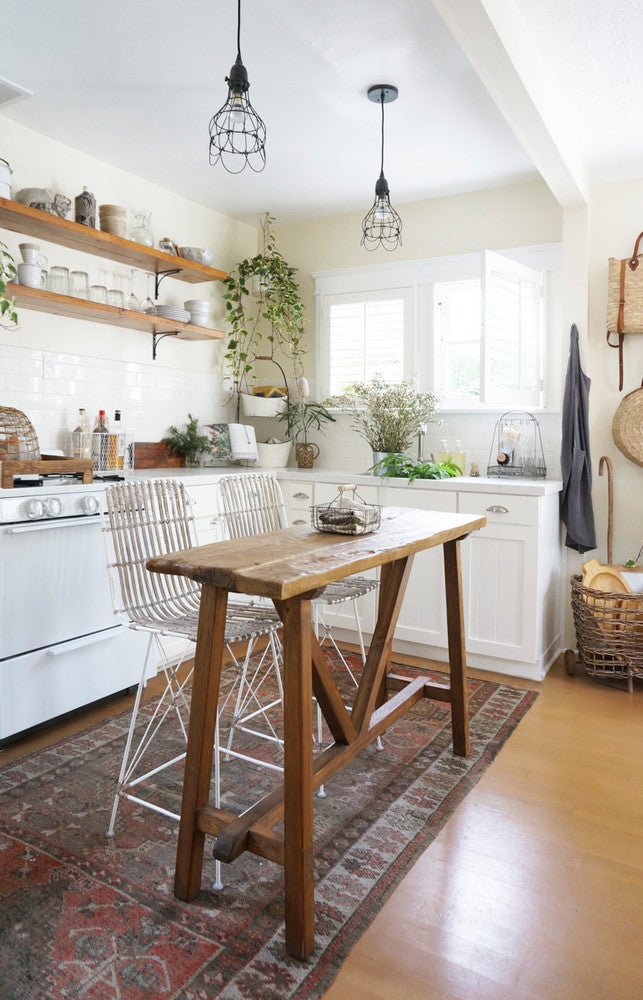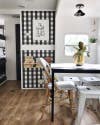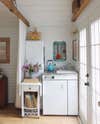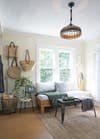Don’t Fall For These Small Space Myths
Every misconception you have about tiny homes, debunked.
Published Aug 17, 2018 12:27 PM
We may earn revenue from the products available on this page and participate in affiliate programs.
Would you rather live in a 7,000-square-foot mansion surrounded by more greenery than the Amazon Rainforest or in a tiny shack with enough space to house you and only one of your three children? While the phrase “living small” often conjures up less-than-stellar visions like the aforementioned shack, downsizing isn’t usually as extreme as that. The reality of small-space living doesn’t have to be one restricted to bland, neutral color schemes and minimal furniture—you don’t have to sacrifice your personality to fit your budget or lifestyle.
How do we know this? We asked the experts. Between some of our favorite tiny home-owners and the professional designers making limited square footage look fabulous, we tracked down our very own team of small-space mythbusters.
Read on to discover the common misconceptions one may have about downsizing, and which you can actually ignore.
You Can’t Have Big Furniture
This one is, without a doubt, the biggest small-space myth we came across and thankfully it’s totally false. “People fixated on the limited square footage of their home buy compact furniture—to fit to size, so to speak,” says Clara Jung, who designed this pink dream of a tiny home in San Francisco. “The result is often an abundance of smaller-scale furniture that creates clutter without any individual piece fully serving its intended purpose.”
Whitney Leigh Morris, the creative brains behind one of our favorite mini houses, the Tiny Canal Cottage in Venice, California, echoes this. “Keep in mind that one larger accessory or piece of furniture is oftentimes more appropriate than several smaller designs. For example, in our tiny cottage, we have a sizable built-in sofa that can comfortably seat five or host two (tall!), overnight guests. The space would be more difficult to navigate with a small couch, ottoman, accent table, and armchairs,” she explains.
It’s all about proportion and optimizing your space—take a page from designer Stacey Cohen, who created this 550-square-foot apartment in Toronto and incorporated larger pieces for a more opulent feel.
“It’s important to buy furniture that’s proportionate to your rooms; I always think less is more in a small space. Best to have large pieces and fewer pieces, it will make areas feel grander.” Zio and Sons founder Anthony D’Argenzio (whose work you’ll remember from this uber Insta-friendly NYC apartment) adds that in addition to reducing clutter, going big will make your small space feel homier.
“Not only will you be optimizing usable square footage, it will also give your living room a sense of warmth and comfort that small spaces often lack,” says D’Argenzio of choosing a large sofa over a small love seat. “Forgo end tables and standing lamps with wall mounted options for added floor space and convenience.”
Finally, large furniture doesn’t have to be clunky. This is best exhibited in photographer Nick Glimenakis’ cool and contemporary 500-square-foot apartment, full of decorative touches that defy the tiny home’s size. “One way to counteract the larger pieces was to choose design elements that rested closer to the ground,” he recommends. “It makes the room feel bigger and leaves plenty of wall space to stack art and let the space breathe.” His living room (above), which stars a stunning burnt sienna-hued sofa, is a perfect example of that design aesthetic.
You Can’t Have Big Art
Think plastering your walls with statement artwork will crowd your space? Think again. Abigail Stone’s 262-Square-Foot NYC apartment is full of pieces she collected over the years, and according to her, it’s part of what makes her tiny home feel bigger. “Go for the full-scale
gallery wallby loading up on art you’ll create the illusion of height—it’s one of my favorite tricks! Pair with a large mirror on the opposite wall to reflect your collection and help with the illusion of space,” she says.
Jung is a fan of investing in one or two larger pieces of art as well, to create a single visual focal point in any room. “One of the benefits of having a compact space? You can make a strong impression with much less and showcase the items you love the most,” she says. Fair point.
You Won’t Have Storage Space
In a tiny home, storage and multifunctional pieces are of the utmost importance, and while it can seem daunting to find enough clever solutions for storing your essentials it’s far from impossible.
“I learned that the secret is [becoming] very efficient with simplifying and staying organized,” shares Melissa Johnson, who runs lifestyle site Best Friends for Frosting and recently decked out a tiny Airbnb in Sacramento with her signature playful style. “To this day, about every four months, I go through all of our closets, drawers, and cupboards to get rid of anything that we either don’t have an instant use for or does not serve our family. My rule of thumb is that I will only buy things that I have an instant use for, which keeps [everything] simplified.”
Less stuff = less of a need for intricate storage solutions. Declutter first, then evaluate what you’re working with.
Not willing to part with your favorites in the name of easier storage? “Don’t ever forget about vertical space!” says designer and blogger Anita Yokota, urging creativity for dealing with small spaces. “When I help clients design their tiny homes and apartments, the first thing I remind them is to look up. All of a sudden, there’s room for hooks, shelves, and even cabinets. It not only draws visual interest upwards—which makes the room seem bigger—but it’s also pretty,” she says.
If You Do Have Storage, It’s Ugly
“Not true,” says designer Kim Lewis. “It’s important to get creative with storage solutions; the functional things in a home can be beautiful, so shop smart. Buy pots, pans, and plates you don’t need to hide. Linens can be stored in vintage suitcases.”
She took her own advice to heart, outfitting her color-filled 560-square-foot South Austin home with both functional and fashionable organization pieces. Retro suitcases under her desk double as a makeshift linen closet. A vintage watchmaker’s cabinet serves as a much more unique accessories organizer than a series of plastic boxes placed atop a dresser.
Stone agrees: “With a bit of savvy, you can find storage solutions you won’t mind looking at,” she says, pointing to the pile of old Hermès boxes she found in the trash and now uses to hold old photographs. “A stack of graduated vintage hat boxes or fabric-covered boxes can also work well.”
You Can’t Have Color
Is this the most overused small-space trope or what? Despite popular belief, you don’t have to turn your
tiny apartmentinto a whitewashed meditation room devoid of any furniture to properly enjoy the space. You can have color and lots of it. “Play with the same color in different shades throughout the rooms of your home to make it feel more inviting,” recommends Johnson. “Be sure to leave the ceilings and trim white so that they don’t stick out like a sore thumb.”
And while it may be counterintuitive, you might want to try your hand at a darker paint color—black, in particular, is having a big moment in the design world right now.
“Darker colors, when done right, can actually make a small space feel larger. A wash of a dark hue hides corners, blurs the lines, and your eye doesn’t realize where the walls stop and start,” says Meagan Camp, who designed this 300-square-foot studio apartment—admittedly in lighter neutrals, but her advice holds true. “Continuing the same color in the furniture, window treatments, and accessories further tricks the eye.”
You Have to Surrender All Your Material Possessions
Okay, downsizing and decluttering can be healthy, but it doesn’t mean you have to toss your favorite pieces in the name of adapting to a smaller space. Blogger Erin Boyle (who was, coincidentally, our “Best Small Space Blog” award recipient at last year’s blogger awards) knows a thing or two about adapting to a tiny home, and the answer doesn’t lie in ridding yourself of all sentimental “clutter.”
“Our one-bedroom apartment is filled with things are meaningful to our family of four, but we don’t feel cramped or crowded in it. The trick, of course, is making sure there are only things we love. If we’re ambivalent or find that something isn’t working for us, we let it go,” she says.
You Have to Sacrifice Your Bold Style
Don’t cramp your style to suit a limited floor plan. “Instead of over packing the space with a bunch of stuff, [I designed] the space with intention and only added in pieces I loved,” says Ashley Petrone, whose bold (check out the gingham wallpaper) 180-square-foot RV houses a large family. “We had an RV that felt like a home and looked beautiful, too.”
If you aren’t sure about going all out with funky patterns and eclectic textiles, try containing the bold moments to smaller parts of your small space. “The most successfully designed small spaces have a neutral backdrop with pops of color or texture in a strategic area. I suggest deciding on a couple focal points for color or texture, and letting those “tell the color story” in your design,” explains Lewis, who went for colorful appliances and a Mexican cement tile backsplash in her own tiny home.
You’ll Be There for the Rest of Your Life
When a year into living in your under-500-square-feet abode, you have a crisis and decide you can’t stand to sleep in the same room you eat in any longer, don’t worry. Small space living isn’t for everyone, and downsizing definitely doesn’t have to signify a huge, permanent lifestyle change.
“Some people will make the shift and go #small4lyfe, but for many other people living in a tiny house, [they live there] because it allows them to live close to family/work/dream location, or it’s what fits within their means at the time,” says Rebekah Carey, whose own 200-square-foot “Bitty Berkeley Bungalow” is packed with personal touches and retro vibes.
She advises thinking about what it will really be like living in a space that does present some very real limitations: holding fewer people, getting messier quicker, etc. “But don’t be pressured by friends or family (or internet trolls) that tell you it isn’t possible. Be present, enjoy this experience, and be open to what possibilities of living this way of life may bring!”
Tiny Houses Aren’t Meant for Families
Blogger Autumn Bailey houses what’s soon to be a family of five in a tiny RV, so you literally have no excuse. “While it’s true there’s bound to be some times where you feel like a bit of a sardine in a can, you don’t need a mansion to
raise a familyYou learn pretty quickly what is essential in a tiny space, and what you can do without. And the truth of the matter is, kids don’t need much: A place to sleep, a couple things to occupy their time, and a lot of love,” she says.
There’s a financial plus to living small, too, that those with growing families are sure to appreciate—it makes you more conscious about where your money goes because you are more likely to see it directly in front of you than if you lived in a massive house. “You spend less money on the ‘bulk’ that comes with child-rearing, and instead of buying tons of over-stimulating [things] that ultimately end up in the trash or seriously clutter your small space, you consciously buy,” she continues.
You’ll Constantly Feel Overwhelmed by Clutter
Take a look at this bright and breezy LA home designed by Melanie Burstin, weighing in at 650 square feet, and tell us if it looks claustrophobic. It doesn’t, right? That’s because Burstin kept the backdrop clean and cohesive, and assigned each area of the home a specific function so as to avoid the feeling of overwhelming clutter.
“Focus on what you use on a daily basis. By keeping your background as clean as possible, you’ll maintain a lofty feeling; try using simple white draperies,” she recommends. “By creating designated homes for all your belongings, you’re more likely to avoid accruing random piles of stuff, and therefore you’ll feel less bogged down by your possessions.”
Your Social Life Will Suffer
If you’re an avid dinner party host worrying about how you’re going to cram everyone into a miniature dining room (or, even more tragically, a “dining nook”), you might just need to refocus how you think about entertaining. Per Stone, “the cozier the space, the better the party”—having less room for guests to meander in and get distracted by concentrates the energy and makes a group more lively.
Pro tip: “Just make sure to keep a window open to let air circulate, and consider vertical serving pieces to help maximize the limited tabletop space you have. Instead of offering a full bar, an attractive glass jug of fancy champagne punch will do the trick and get the party going,” says Stone.
You’ll End Up with Tons of Wasted Space
Stone is also a big proponent of creatively configuring your fixtures, tailoring them to your new smaller space rather than expecting the space to fit your furniture that was previously used in a larger area. For example, “If your sofa has legs, try some under-bed storage drawers with a shallower depth so you can’t see them—this became my linen closet!” she says. Dead space doesn’t have to go to waste.
You Won’t Have Privacy
From a logistics perspective, this myth seems like a fairly real one: Fewer rooms mean fewer places to hide when you need a moment alone, right? According to Lewis, there are ways to deal with this so you don’t have to give up your privacy. “Use barn doors or bookshelves to separate spaces,” she says, pointing to her own home which is actually divided into two units by an exterior breezeway.
You Won’t Have to Clean as Much
Sorry to be the bearers of bad news, but as much as you might want this misconception to be true, it isn’t. Kate Oliver and Ellen Prasse renovate airstreams for a living, even calling one of the chic spaces their own home. The couple, who run The Modern Caravan, therefore have more than their share of experience dealing with the upkeep of a tiny space, and the prognosis isn’t good.
“Living tiny doesn’t mean you’re automatically a minimalist who lives a neat and tidy existence!” says Oliver, pointing to everyday messes like dirt from the outside or splatter from cooking in the kitchen as being particularly evident when there’s less space. “We regularly have to purge, edit, and streamline, as both my wife and I are avid thrifters. Living tiny is a process and a continual discipline, and rarely looks like Instagram says.” You’ve been warned.
You Can’t Live Comfortably
Simply put, after a certain time living in a small space, you will hardly recognize its size. “I never think of my home as tiny—perhaps that’s the biggest misconception of all,” says Lauren Gerrie. Her 265-square-foot apartment boasts an open living room and bedroom, conducive to “blasting music and dancing around the apartment”.
“An environment can be grand and full and colorful and spacious if the layout is in accordance with the flow of your lifestyle,” Gerrie reminds us. “I’ve placed importance on wall space and plants nesting on different surfaces at alternating heights. Great art and lots of plants, that’s what gives life to my home.” Get your priorities sorted, and you’ll be loving your tiny home in no time.
See more small space tips: 9 Clever Nightstand Alternatives for Small Spaces 10 Easy Storage Solutions if You Don’t Have a Closet How to Make the Most of a Small Bedroom
Learn to love your inbox again—sign up for Domino’s daily email.















